Music & Dance
As with image making, Aboriginal music also unites consciousness with the invisible laws and energy patterns of nature
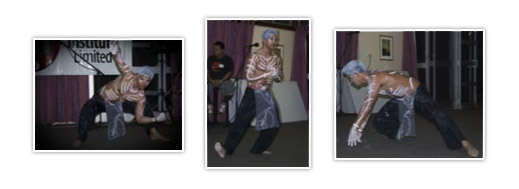
Music and dance are important to Aboriginal culture. They are used as part of everyday life and to mark special occasions. Songlines tell stories of the Creation and Dreamtime as Aboriginals made their journeys across the desert, while other sacred music is used in ceremonies. By singing the songs in the appropriate order indigenous Australians could navigate vast distances in the hostile desert environment.
Ceremonies
Music is an integral part of Aboriginal ceremonies, also known as corroborees. Through mime and song they tell the mythical history of their tribe. There are sacred and non-sacred ceremonies. During sacred ceremonies people from outside of the community are not allowed to attend. Non-sacred ceremonies are usually performed at night in front of the men, women and children of the tribe. A group of adult men, seated around a small fire, chant one of their ancient songs. Others through dance and song, act out different elements of the myth they are telling. Each Tribe can have leaders in both song and dance. The ‘Songman’ composed songs to describe day-to-day events as well as singing ancient songs passed down through generations. Dancers were also very important -the best dancers being highly regarded. Traditional dancing involves arm, body and foot movements and a lot of foot stamping. Dances were often imitations of the movements of animals or birds.
Musical Instruments
Didgeridoo
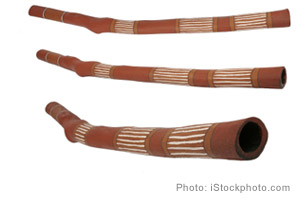
The didgeridoo is a traditional Aboriginal instrument which is believed to be over 1,500 years old and the oldest wind instrument in the world. This is confirmed by its appearance in ancient paintings in caves and shelters. As part of Aboriginal culture it is used as an accompaniment to songs and chants. Traditionally, it is made from the Eucalyptus trees located in the North of Australia, which were hollowed out by termites. It consists of a long tube, without fingerholes, through which the player blows. Aboriginals try to replicate the sounds of nature like animals, wind, water, etc., within the droning sound of the didgeridoo.
How Traditional Didgeridoos are made
Selection of Trees – Once an appropriate location is found, usually in Northern parts of Australia, an aboriginal craftsman taps the trees to see if it is hollow and suitable trees are cut down.
Clean-out – Termites leave a residue in the hollowed out tree which must be cleaned out. This is done by soaking the wood for a few days in water then prising out the residue with a stick or coals.
Sealing – The outside bark is stripped and the stick is then tested for any holes. The stick is sealed from air at both ends and placed in water to check for bubbles. If bubbles are detected the holes are sealed with bees wax.
Mouthpiece – The stick is then cut to size and bee’s wax is places around the mouthpiece to achieve a smoother seal.
Decoration – The final step in the process is decorating the instrument through painting and carving symbols on the outside wood.
Other Instruments
Other well known traditional Aboriginal instruments include the bullroarer and the gumleaf:
Bullroarer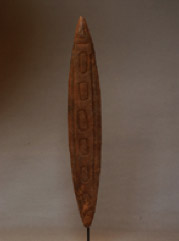 A piece of wood is attached to a long string, which is swung around to produce a pulsating low-pitched roaring sound. They are used in men’s initiation ceremonies and the sound they produced is considered by some Indigenous cultures to represent the sound of the Rainbow Serpent.
A piece of wood is attached to a long string, which is swung around to produce a pulsating low-pitched roaring sound. They are used in men’s initiation ceremonies and the sound they produced is considered by some Indigenous cultures to represent the sound of the Rainbow Serpent.
Source: www.tribalhunter.com/aboriginal-tribal-art.php
Gum-leaf
A leaf from a Eucalyptus tree is held against the lips and blown so as to act as a vibrating valve. The leaf is held tightly against the lower lip and, in a bent shape, lightly against the upper lip. It is then stretched tightly between the two hands to make a high-pitched sound, which was originally intended to imitate birdcalls. The gum-leaf received a popular following in 2007 when Australia’s Got Talent contestant Herb Patten got to the finals with his own gum leaf versions of songs like John Lennon’s ‘Imagine’ and ‘Unchained Melody’.
(see www.arts.vic.gov.au for a sample)
Contemporary Music
Today traditional Aboriginal songs and styles are becoming more popular in mainstream music. In recent times traditional sounding musicians have become popular in Australia and around the world:
Geoffrey Gurrumul Yunupingu
Geoffrey Gurrumul Yunupingu is an Indigenous Australian singer whose music is becoming increasingly popular in the Australian charts. He was born blind and speaks very little English. He speaks the Yolngu language and is from Northern Australia. At the age of 15 he was identified as a young and extremely talented musician and joined the ARIA Award winning band Yothu Yindi. Once released, his debut album grew steadily in popularity and eventually hit number 4 in the Australian charts. It also entered the European World Music Chart at number 8 in September 2008. He was nominated for 4 ARIA (Australian Recording Industry Association) awards and won awards for Best World Music Album and Best Independent Release. In 2009 Yunupingu was honoured with the Northern Territory Australian of the Year title confirming the increasing popularity and interest in traditional Aboriginal music and culture.
Contemporary Dance
Interest in Aboriginal dance, which is associated with traditional ceremonies, has also grown in popularity. Bangarra Dance Theatre is a dance company, which through performance and art, tells the story of Indigenous Australian history. It is ‘fuelled by the spirit, energy and inspiration derived from the culture, values and traditions of Indigenous Australians’. As well as gaining in popularity as one of the leading dance companies in Australia, Bangarra’s popularity has grown outside of Australia where they have toured in North America, Japan and Europe.
“At Bangarra, I love that the dance is not shoving things down your throat saying, ‘Yeah, you white people have done this and that.’ Instead it’s saying we’ve got this amazing, beautiful culture here. We’ve had social issues, we’ve had genocide, we’ve had these things happen to us but look at what we have now. We can tell our stories with the majesty and poetry that the best dance can deliver and through a contemporary dance language that also holds the traces of a culture that is thousands of years old.”
Frances Rings, Choreographer
For more information on Aboriginal Music and Dance check out:
- For all you need to know about didgeridoos and traditional Aboriginal music, see:https://aboriginalart.com.au/didgeridoo/default.htm
- https://www.bangarra.com.au/ gives you more information and insight into the people behind one of Australia’s most exciting dance groups.
- See https://www.gurrumul.com/ for up-to-date information on Geoffrey Gurrumul Yunupingu and some footage of some live performances by the artist.
- View https://www.youtube.com/watch?v=VCWNsj_LcaA to see Herb Patton in action and hear what the gum-leaf sounds like.
- For a list of Aboriginal and Torres Strait Islander music see: https://www.musicaustralia.org/apps/MA?function=viewTheme&name=Aboriginal+and+Torres+Strait+Islander+music
Aboriginal Art
‘When I look at my tjukurrpa [dreaming] paintings it makes me feel good – happy in kuturu (heart), spirit. Everything is there: all there in the caves, not lost. This is my secret side. . . The people keep their ceremony things and pictures – they make them new. They bring young boys for learning to the caves – telling the stories, giving the laws from grandfathers’ fathers, learning to do the paintings – tjukurrpa way.’
Larry Jakamarra Nelson, a Warlpiri man and teacher of the old traditions who lives at Yuendumu in the Northern Territory
Overview
For thousands of years Aboriginals have used art as a means of telling stories about the past, present and future. It is used as part of sacred ceremonies and is deeply connected to the Dreamtime. It is an expression of Aboriginal spiritual beliefs. Art is also used for non-sacred purposes such as explaining stories to children or recording memorable or significant events.
Aboriginal art, unlike western art, is less about individual expression and more about collective shared experience(s). Aboriginal Australians traditionally used art as a means of expression in different forms such as cave paintings, rock engravings, designs cut into trees, ground mosaics, wooden articles such as boomerangs and on their clothing and bodies (scarification). There is significant meaning to whatever they drew, engraved or painted onto such surfaces as sand, earth, rock, trees or wood.
“In Aboriginal languages, there is no one definition for the term art. Aboriginal art is our expression, our culture, our living. An extension of our identity. Not just an item for a wall or living room.”
Brenda Croft ñ Boomalli
Types of Art
Aboriginal Art can be found in different forms. Some types of traditional art is said to date back as far as 40,000 years but in more recent times Aboriginal art has had a new influence on and from contemporary art in Australia.
‘Aboriginal peoples have been producing visual art for many thousands of years. It takes many forms – ancient engravings and rock art, designs in sand or on the body, exquisite fibre craft and wooden sculptures, bark paintings and more recently an explosion of brilliant contemporary painting’
Mickey Durrng, Aboriginal tribal leader and artist, Howard Island
Rock Art
Aboriginal rock art is a traditional form of art, which has been used by Indigenous Australians for thousands of years. Some of the oldest surviving pieces of rock art found are estimated to be between 20,000 and 40,000 years old. Some images represented the actual spiritual energy of the creative ancestors and when repainted or retouched as part of a ritual their sacred power was released. Rock art can be found as both engravings – usually situated outside – and rock painting found in sheltered areas like caves.
Bark Painting
Bark painting by Aboriginal people is a long tradition, perhaps extending back thousands of years. They were usually drawn with charcoal, and painted or scratched onto smoke-blackened bark. Bark painting was mostly used as part of everyday life. They were used to illustrate stories which were told to young people during the long hours of the wet season when they were confined to stay in their shelter.
Body Painting

The art of body painting carries deep spiritual significance for Australian Aboriginal people. Body decoration includes face and body painting used in rituals as well as the transformation of the body to form living images of ancestral beings. Scarring was mainly used as part of ceremonies to mark age, initiation or to raise a person’s status. For Indigenous Australians, body painting is not necessarily just about visual artistic creativity, it relates to rituals, laws and religion.
‘Body paint for us is really important for our culture, for sharing with other people too. Some people don’t recognise me when I do painting, when I am performing.’
Djakapurra Munyarryun, Bangarra Dance Theatre
Contemporary Art

Since the turn of the last century Aboriginal art has used new materials and resources to carry on the traditional and significant role art plays in their culture. Modern times have led to the use of acrylic paint and canvas to portray the traditional beliefs of the Aboriginal people through art. Acrylic paintings by Australian Aboriginal people are one of the most exciting developments in modern Australian art. Paintings, dances and songs relating to the Dreamtime are repeating the work of Ancestors, thus keeping the Dreaming alive.
‘It is no longer good enough to have Aboriginal Art on the walls of our places of importance – the Spirit of the land coming through that Art must be allowed to shape and mould us going forward.’
Patrick Dodson, Director of the Kimberly Institute
Artists
Albert Namatjira
Albert Namatjira was born in 1902 and is a Western Arrernte man from the lands west of Alice Springs. He is best known for his watercolour Australian outback desert landscapes. He is also notable for being the first Northern Territory Aboriginal to be freed from the restrictions of discriminatory legislation that made Aboriginals wards of the State. In 1938 his first exhibition was held in Melbourne and subsequent exhibitions in Sydney and Adelaide also sold out. Queen Elizabeth II became one of his more notable fans and he was awarded the Queen’s Coronation medal in 1953 and met her in Canberra in 1954. Due to his growing wealth, Namatjira soon found himself the subject of “humbugging”, a ritualised form of begging. Arrernte are expected to share everything they own, and as Namatjira’s income grew, so did his extended family. At one time he was single-handedly providing for over six hundred people. He died of heart disease complicated by pneumonia on August 8, 1959 in Alice Springs. Albert Namatjira is hailed as one of the greatest Australian artists and a pioneer for Aboriginal rights. Today, Namatjira’s work is on public display in some of Australia’s major art galleries.
Dorothy Napangardi
‘When I paint I think of the old days, as a happy little girl knowing my grandfather’s Dreaming.’
Dorothy Napangardi https://www.crownpoint.com/artists/174/about-artist
Dorothy Napangardi was born in the 1950s and is a distinguished Australian Aboriginal artist from Mina Mina in Central Australia. She had little formal schooling, but was taught through the historic Dreaming of her people. She has five daughters (two of them artists) and four grandchildren who live in Yuendumu and Alice Springs. She lives in Alice Springs and Sydney. Napangardi began painting in 1987, after she had moved from her home in the outback to Alice Springs. There, she enrolled at the Institute for Aboriginal Development to learn to use Western painting materials, and in 1990 began exhibiting at Gallery Gondwana in Alice Springs. In 2001 Napangardi won first prize in the 18th National Aboriginal and Torres Strait Islander Award, for her work Salt on Mina Mina. Napangardi’s work is found in many museums and collections worldwide. She is one of the most sought-after of contemporary Aboriginal artists, with her art fetches record prices at auctions. The highest auction price so far is $129,750.00 for her work entitled Karntakulangu.
Websites for further information:
- For a look at examples of Aboriginal art and for biographies on artists by region check outhttps://www.aboriginalartonline.com/art/artists.php
- Go to https://www.eniar.org/action/burrup.html to find out more about the ‘Burrup peninsular rock art campaign’, which is fighting to stop development at one of the world’s largest rock art sites
- Go to https://www.creativespirits.info/aboriginalculture/arts/aboriginal-art-authenticity.html for a guide on how to buy authentic Aboriginal art
More on developmenteducation.ie
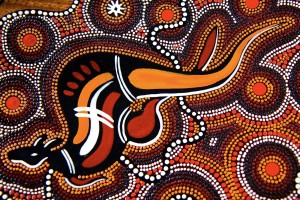
What is it about us? The non-Indigenous peoples of Australia
On Australia Day, Phil Glendenning reflects on the colonial facts of Australia’s history, the disregard for its First People and the urgency to act now following the killing of George Floyd

Generation Lockdown – Thailand, Uganda, Italy, Brazil, Australia & Sweden
Three new videos from the Generation Lockdown video series where young people from across the world react to the Coronavirus pandemic

5 great teacher-focused websites: Supporting students through coronavirus
A starter list of 5 great teacher focused online sources covering a range of Covid-19 related materials suitable for many subjects, including CSPE, English, Business Studies, Politics & Society, Geography, Mathematics, Science, Transition Year modules, Home Economics, Environmental Education and beyond

5 ideas to NOT borrow from Australia’s asylum policy
developmenteducation.ie recently spoke with an old friend and colleague Phil Glendenning, director of the Edmund Rice Centre in Sydney and now president of the Refugee Council of Australia, about Australia’s offshore and onshore asylum seeker detention system.
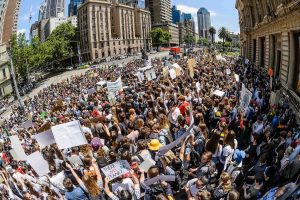
What we’re reading: historian takes on Davos titans and Greta Thunberg takes on her critics
‘It feels like I’m at a firefighters conference and no one’s allowed to speak about water’
Patrick Dodson: ‘We’ve been here for over 60,000 years and are not recognised in our own lands’ – interview
In a developmenteducation.ie and 80:20 Educating and Acting for a Better World exclusive, Colm Regan caught up with Aboriginal leader and campaigner Patrick Dodson during
